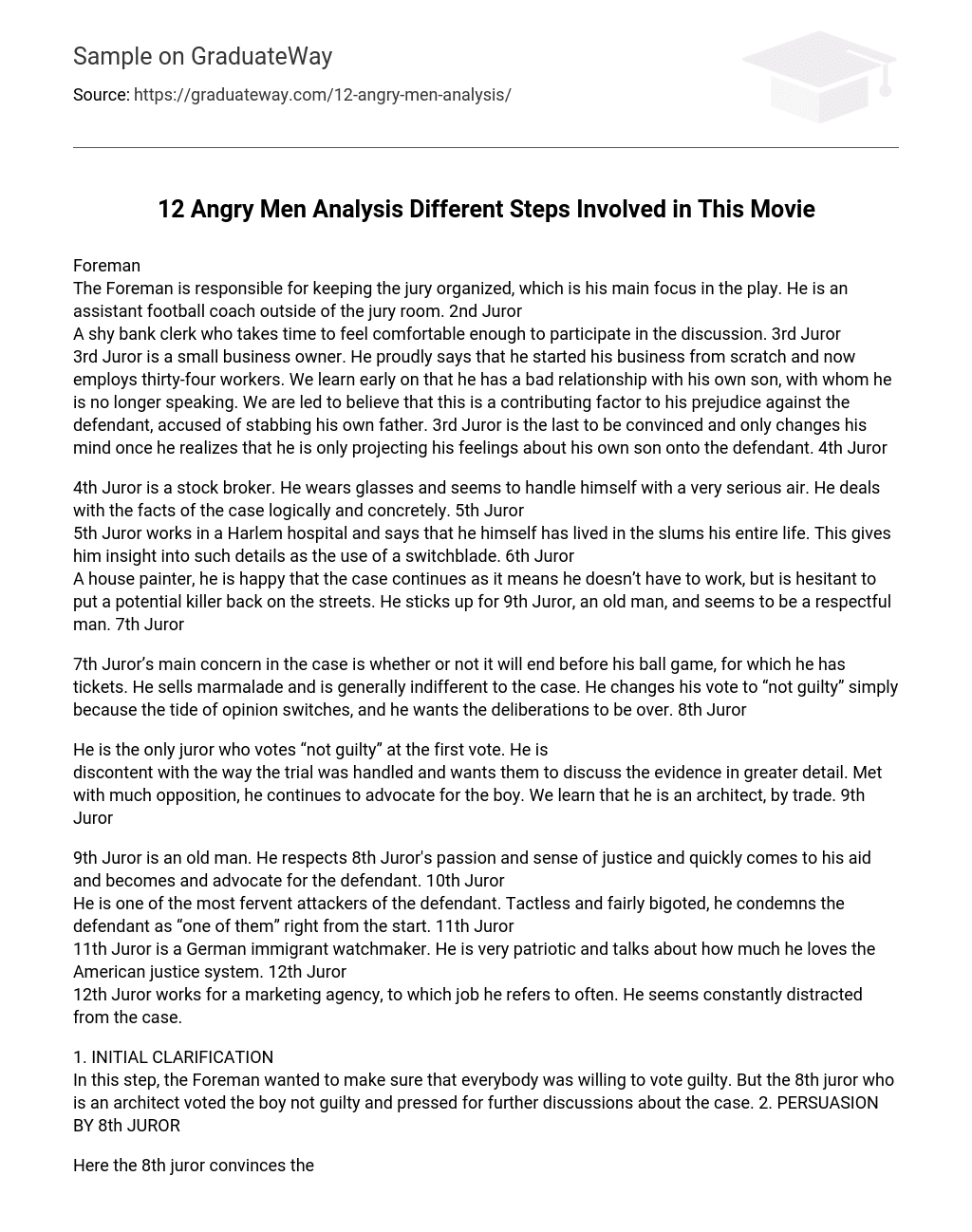Foreman
The Foreman is primarily focused on keeping the jury organized in the play. Outside of the jury room, he works as an assistant football coach.
2nd Juror
A shy bank clerk who takes time to feel comfortable enough to participate in the discussion.
3rd Juror
3rd Juror is a small business owner. He proudly started his business from scratch and employs thirty-four workers. It is revealed that he has a strained relationship with his son and they no longer speak. This personal issue leads to his prejudice against the defendant accused of stabbing his own father. 3rd Juror only changes his mind when he realizes that he was projecting his feelings about his son onto the defendant.
4th Juror
The 4th Juror is a stock broker and appears very serious, wearing glasses. He approaches the case with logical and concrete reasoning. Meanwhile, the 5th Juror works at a Harlem hospital and has personal experience living in the slums. This background allows him to understand details such as the use of a switchblade. The 6th Juror, a house painter, is pleased that the case is ongoing as it means he doesn’t have to work. However, he is hesitant to release a potential killer into society and defends the 9th Juror, an elderly man. The 7th Juror.
The main concern of the 7th Juror in the case is whether it will finish before his ball game, for which he has tickets. He is a marmalade seller and generally apathetic towards the case. He changes his vote to “not guilty” solely because the majority opinion shifts, and he desires for the deliberations to conclude. The 8th Juror.
The first vote results in only one juror voting “not guilty”. This juror is discontent with the trial’s handling and urges a more detailed discussion of the evidence. Despite facing opposition, he persistently defends the accused. Additionally, we discover that he works as an architect. He is known as the 9th Juror.
9th Juror is an old man who quickly becomes an advocate for the defendant, respecting 8th Juror’s passion and sense of justice. On the other hand, 10th Juror is one of the most fervent attackers of the defendant, being tactless and fairly bigoted from the start, condemning the defendant as “one of them”. 11th Juror is a German immigrant watchmaker who is very patriotic and expresses love for the American justice system. Lastly, 12th Juror, who works for a marketing agency, frequently refers to his job and appears constantly distracted from the case.
1. INITIAL CLARIFICATION
The Foreman ensured that everyone was ready to vote guilty. However, the 8th juror (an architect) voted not guilty and insisted on further discussion regarding the case. 2. PERSUASION BY 8th JUROR
In this passage, the 8th juror persuades the rest by presenting multiple concrete instances where someone else could have been responsible for the murder of the boy’s father. Gradually, he forms a coalition with a small number of jurors who opt to vote not guilty. Additionally, the text mentions crime scene analysis and the creation of a fabricated killing.
The jury members reenacted the crime scene to determine how the witnesses could have been mistaken. Over time, a majority of the jury members gradually changed their verdicts to support the 8th juror. 4. COMMON CONCLUSION
The last jury member left to be convinced was someone who had been dealing with personal issues with his son. Ultimately, he also becomes convinced and agrees to support the suspect. COLLECTIVE DECISION MAKING
The text emphasizes the benefits of group decision-making, highlighting how collective memory and diverse perspectives contribute to fair decisions. The film effectively portrayed this concept by presenting arguments for and against a guilty verdict, ultimately resulting in a fair “not guilty” verdict. Another advantage is the reduction of prejudice as individual biases can be identified and eliminated within a group. Furthermore, group decision-making fosters creativity and innovation compared to individual decision-making. Lastly, there is a shared understanding among group members in the decision-making process.
TEAM WORK
In the film 12 Angry Men, we witness a powerful illustration of how diverse and conflicting viewpoints can come together to create a cooperative community. It is crucial to note how Henry Fonda, portrayed as the 8th Juror, successfully builds this community amidst the various perspectives expressed during the deliberation.
GROUP DYNAMICS
The film shows how leadership can minimize rivalries and constructively integrate opposing views, contributing to effective coalitions. The main character, played by Fonda, takes a positive step by adopting an overall approach that encourages the constructive integration of opposing views. In the film, the jurors’ differing perspectives are utilized to understand different points of view. The underlying theme presented is that multiple perspectives can lead to the best solution. To minimize rivalries and integrate opposing views, it is important to see diversity as an opportunity rather than a threat to progress. Effectively handling varying perspectives allows for greater understanding.





